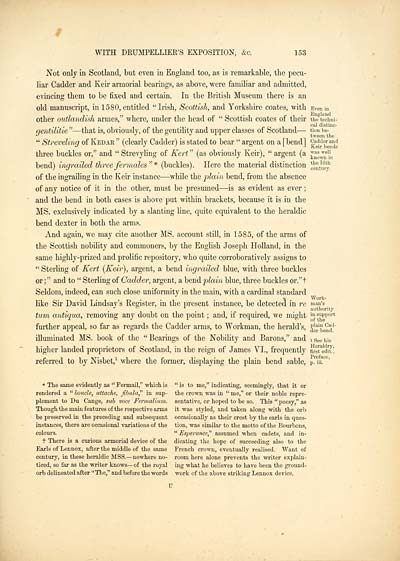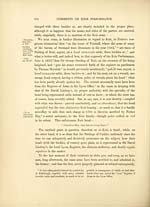Download files
Complete book:
Individual page:
Thumbnail gallery: Grid view | List view

WITH DRUMPELLIER'S EXPOSITION, &c. 153
Not only in Scotland, but even in England too, as is remarkable, the pecu-
liar Gadder and Keir armorial bearings, as above, 'svere familiar and admitted,
evincing them to be fixed and certain. In the British Museum there is an
old manuscript, in 1580, entitled "Irish, Scottish, and Yorkshire coates, with Even in
other outlandish armes," where, under the head of " Scottish coates of theu* the tecbni-
cal distinc-
gentilitie " — that is, obviously, of the gentility and upper classes of Scotland — tion be-
" Streveling of Kedae " (clearly Gadder) is stated to bear " argent on a [bend] g'j!'*^''^^'*
three buckles or," and " Strevyling of Kert " (as obviously Keir), " argent (a ^^^^^^^'/^
bend) ingrailed three fermcdes"* (buckles). Here the material distinction *gntary!
of the ingrailing in the Keir instance — while the plain bend, from the absence
of any notice of it in the other, must be presumed — is as evident as ever ;
and the bend in both cases is above put within brackets, because it is in the
MS. exclusively indicated by a slanting Une, quite equivalent to the heraldic
bend dexter in both the arms.
And again, we may cite another MS. account still, in 1585, of the arms of
the Scottish nobility and commoners, by the English Joseph Holland, in the
same highly-prized and prolific repository, who quite corroboratively assigns to
" Sterling of Kert {Keir), argent, a bend ingrailed blue, with three buckles
or;" and to " Sterling of Cadder, argent, a bend 2ylain blue, three buckles or."t
Seldom, indeed, can such close uniformity in the main, with a cardinal standard
* Work-
like Sir David Lindsay's Register, in the present instance, be detected in re man's
authority
turn antiqua, removing any doubt on the point ; and, if required, we might insuppok
fiu'ther appeal, so far as regards the Gadder arms, to Workman, the herald's, Je^^bend'
illuminated MS. book of the "Bearings of the Nobility and Barons," and i see his
higher landed proprietors of Scotland, in the reign of James VI., frequently firsredR.',
referred to by Nisbet,^ where the former, displaying the plain bend sable, p.lii.
* The same evidently as "Fermail," which is "is to me," indicating, seemingly, that it or
rendered a " houcle, attache, fibula" in sup- the crown was in "me," or their noble repre-
plement to Du Cange, suh voce Fermalium. sentative, or hoped to be so. This " poesy," as
Though the main features of the respective arms it was styled, and taken along with the orb
be preserved in the preceding and subsequent occasionally as their crest by the earls in ques-
instances, there are occasional variations of the tion, was similar to the motto of the Bourbons,
colours. " Esperance^^ assumed when cadets, and in-
t There is a curious armorial device of the dicating the hope of succeeding also to the
Earla of Lennox, after the middle of the same French crown, eventually realised. Want of
century, in these heraldic MSS. — nowhere no- room here alone prevents the writer explain-
ticed, so fai' as the writer knows — of the royal ing what he believes to have been the gi'ound-
orb delineated after "The," and before the words work of the above striking Lennox device.
U
Not only in Scotland, but even in England too, as is remarkable, the pecu-
liar Gadder and Keir armorial bearings, as above, 'svere familiar and admitted,
evincing them to be fixed and certain. In the British Museum there is an
old manuscript, in 1580, entitled "Irish, Scottish, and Yorkshire coates, with Even in
other outlandish armes," where, under the head of " Scottish coates of theu* the tecbni-
cal distinc-
gentilitie " — that is, obviously, of the gentility and upper classes of Scotland — tion be-
" Streveling of Kedae " (clearly Gadder) is stated to bear " argent on a [bend] g'j!'*^''^^'*
three buckles or," and " Strevyling of Kert " (as obviously Keir), " argent (a ^^^^^^^'/^
bend) ingrailed three fermcdes"* (buckles). Here the material distinction *gntary!
of the ingrailing in the Keir instance — while the plain bend, from the absence
of any notice of it in the other, must be presumed — is as evident as ever ;
and the bend in both cases is above put within brackets, because it is in the
MS. exclusively indicated by a slanting Une, quite equivalent to the heraldic
bend dexter in both the arms.
And again, we may cite another MS. account still, in 1585, of the arms of
the Scottish nobility and commoners, by the English Joseph Holland, in the
same highly-prized and prolific repository, who quite corroboratively assigns to
" Sterling of Kert {Keir), argent, a bend ingrailed blue, with three buckles
or;" and to " Sterling of Cadder, argent, a bend 2ylain blue, three buckles or."t
Seldom, indeed, can such close uniformity in the main, with a cardinal standard
* Work-
like Sir David Lindsay's Register, in the present instance, be detected in re man's
authority
turn antiqua, removing any doubt on the point ; and, if required, we might insuppok
fiu'ther appeal, so far as regards the Gadder arms, to Workman, the herald's, Je^^bend'
illuminated MS. book of the "Bearings of the Nobility and Barons," and i see his
higher landed proprietors of Scotland, in the reign of James VI., frequently firsredR.',
referred to by Nisbet,^ where the former, displaying the plain bend sable, p.lii.
* The same evidently as "Fermail," which is "is to me," indicating, seemingly, that it or
rendered a " houcle, attache, fibula" in sup- the crown was in "me," or their noble repre-
plement to Du Cange, suh voce Fermalium. sentative, or hoped to be so. This " poesy," as
Though the main features of the respective arms it was styled, and taken along with the orb
be preserved in the preceding and subsequent occasionally as their crest by the earls in ques-
instances, there are occasional variations of the tion, was similar to the motto of the Bourbons,
colours. " Esperance^^ assumed when cadets, and in-
t There is a curious armorial device of the dicating the hope of succeeding also to the
Earla of Lennox, after the middle of the same French crown, eventually realised. Want of
century, in these heraldic MSS. — nowhere no- room here alone prevents the writer explain-
ticed, so fai' as the writer knows — of the royal ing what he believes to have been the gi'ound-
orb delineated after "The," and before the words work of the above striking Lennox device.
U
Set display mode to:
![]() Universal Viewer |
Universal Viewer | ![]() Mirador |
Large image | Transcription
Mirador |
Large image | Transcription
Images and transcriptions on this page, including medium image downloads, may be used under the Creative Commons Attribution 4.0 International Licence unless otherwise stated. ![]()
| Permanent URL | https://digital.nls.uk/95372627 |
|---|
| Description | A selection of almost 400 printed items relating to the history of Scottish families, mostly dating from the 19th and early 20th centuries. Includes memoirs, genealogies and clan histories, with a few produced by emigrant families. The earliest family history goes back to AD 916. |
|---|

